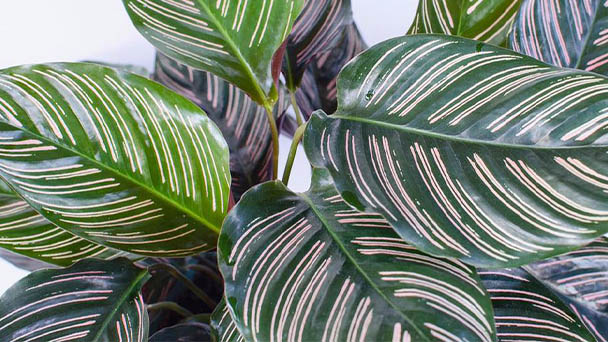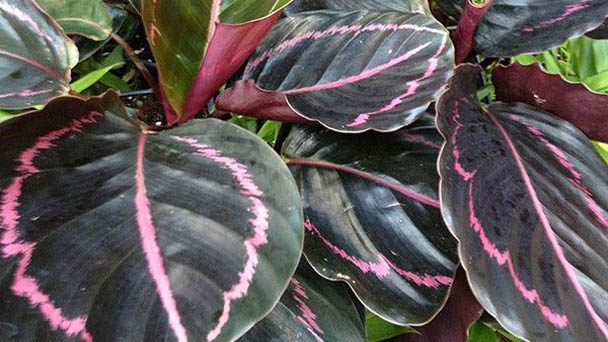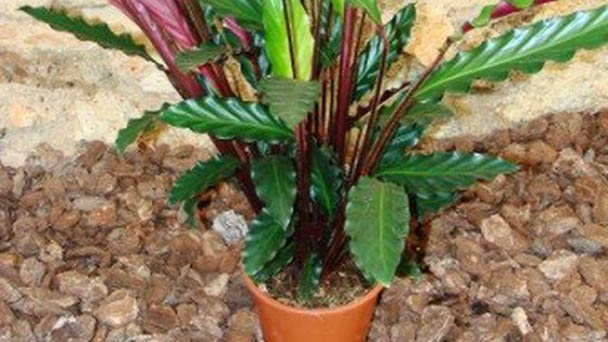Calatheas Plant Care & Propagation Guide
Written by Ivy
Nov 01 2021

Calatheas Quick Info
| Botanical/Scientific Name | Calathea |
| Common Name | Peacock plants, zebra plants, rattlesnake plants and prayer plants |
| Varieties | Calathea Orbifolia,Calathea Warscewiczii,Calathea Makoyana, Calathea Crocata, Calathea Ornata, Calathea Zebrina, Calathea Lancifolia |
| Uses | Indoor office decoration purposes |
| Origin | Jungles of the Amazon in South America |
| Light Care | Bright, but not direct, sunlight to grow |
| Soil Care | Moist soil |
| Temperature Care | Between 65-80 degrees |
| Humidity Care | A humidity level of 50 percent or more |
| Watering | Weekly waterings |
| Pruning Care | Cut the leaf with a sharp knife or a pair of scissors near the steam |
| Fertilizer Care | Balanced all-purpose fertilizer like a 10/10/10 on the NPK ratio |
| Propagation | By division at repotting time in the spring |
| Toxic | Non-toxic to both cats and dogs |
Calatheas Care in Detail

Calatheas Watering
Calathea likes a slightly wet environment. When the plant grows well, it should be given enough water. In spring and autumn, we can water calatheas plant every 5 days. It's ok if there is no ponding at the root of the plant. When the temperature is low in winter, we will enter the sleeping period. We need to control watering. Just watch that the calatheas basin soil is not too dry. We can water normally when spring comes.Calatheas Soil
Calatheas plant is not particularly strict on the growing soil. As long as the appropriate humidity is maintained, fertilizer should be applied every two weeks when it grows well. In winter, the basin soil should be slightly dry. In reducing the number of fertilization, most of the breeding is carried out by dividing roots or cutting branches.
Calatheas light
Calathea flora want bright, however now not direct, daylight to grow. This is due to the fact Calatheas develop on the ground of jungles and forests the place Calatheas plant get restrained mild via the tops of the trees. In fact, direct daylight will burn the leaves of a Calathea plant and motive it to lose its shiny colors.If you take care to water the proper quantities with the proper kind of water, maintain the humidity degree and indoor air temperatures simply right, you can have beautiful, inexperienced vegetation that will brighten up workplace and indoor spaces. Lobbies, assembly rooms, and cubicle areas that are excessive in humidity and have the proper temperatures and oblique daylight are all accurate locations for Calathea. Atriums are top notch places for Calathea as well.
Calatheas Temperature
Calathea cannot be exposed to direct sunlight. It likes to grow in a soft and slightly wet environment. When planting, we should give it a certain degree of shade and keep the temperature between 12 ℃ and 30 ℃. Calatheas temperature in winter is about 15 ℃. Calatheas is a season of vigorous growth in spring and summer, We should keep a certain humidity in the air around the plants. If the humidity is not high, we can spray fog around the plants.No matter what kind of calatheas plant, the growth habits of calatheas plant are similar. The original living environment is in the tropical region of America. Calatheas, who lives in the rainforest, likes the living environment of high temperature and humidity, but is afraid of dry, windy and cold weather. In the low temperature and dry season in winter, the main reason for the phenomenon of dry leaf tip or leaf curling in calatheas. We can artificially help it raise the breeding temperature, move calatheas to a room higher than 15 degrees, give warm protection, and it can grow vigorously in winter.
Calatheas Humidity
If you can grant greater humidity for your Calathea plants, please go in advance and do so.It is NOT the most vital issue in maintaining most of your Calathea species in precise shape, however Calatheas plant DO choose humid environments.
First of all, misting will do nothing to make bigger humidity! Humidity is a measure of moisture in the air. You are simply wetting the leaves by way of misting.
That being said, Calathea can be inclined to spider mites and misting can honestly help deter spider mites (since spider mites like very dry conditions). There is one advantage to misting!
Another way to make bigger humidity is to team flora together. Plants naturally launch water into the air by using a technique referred to as transpiration.
The greater you crew together, the extra the localized humidity will increase.
Calatheas Fertilizer
For calatheas fertilization, especially in the season of vigorous growth, liquid fertilizer should be applied once a month to supplement the nutrients required by plants, make the leaves of plants more shiny, and apply potassium fertilizer as much as possible. When the malachite taro lacks fertilizer, the plant will become short and inactive. Calatheas plant fertilizer should not be applied too much to prevent fertilizer damage. After fertilization, a small amount of water can be used. We don't need to apply calatheas plant in winter because it is dormant at this time.
Calatheas Pruning
As plant life mature and leaves age, it is frequent for some of the outer leaves to yellow or brown. Removing yellowed or browned outer leaves frequently improves the look of your calathea plant. Cut leaves at the base the place the leaf joins the major stalk with a pair of sharp scissors. Occasional lifeless leaves is no longer a reason of alarm, however, regular or immoderate yellowing can also be an indication of disorder or wrong lights and ought to be investigated.If the hassle is pretty small then you may now not have to do away with whole leaves and alternatively simply provide your leaf a bit of a trim. If your leaves are nonetheless intact however Calatheas've developed moderate crisping on the guidelines then you can in reality trim the guidelines as a substitute than doing away with the leaf. Get a pair of sharp scissors and cautiously reduce away the brown areas of the leaf leaving the majority of the foliage nevertheless intact.
Not solely will you be assisting the plant however you will additionally be making your Calathea extra captivating once more due to the fact let's face it, no one likes searching at crispy tips.
Calatheas Repotting
It is an exact notion to repot your calathea as soon as each and every yr or each different yr to supply it clean soil and nutrients.When to repot Calatheas - Once a 12 months or each and every different year.
Pot sizing - if you favor your plant to develop wider, locate a nursery pot it is 2”in diameter large than the cutting-edge pot. If you desire your plant to continue to be the equal size, you can reuse the equal pot and definitely alternate the soil.
Get your fingers soiled - unfold out newspaper on the floor, do away with the plant from the pot and shake off as lots of the historical soil as feasible so that you have easy roots. Place the plant in the middle of the pot, add new soil and pat down firmly. Water the soil totally and region the plant in a vicinity with shiny oblique light. Your plant will take 2-4 weeks to settle from the shock and alter to its new home.
Calatheas Pest & Disease Control
Curled leaves and brown leaf-edges are the end result of too little water or over-exposure to the sun. Calathea are pleasant positioned in bright, oblique settings, and these that have not acclimatised to the harsh rays will exhibit signs and symptoms of sun-scorch and environmental shock. A splash of iciness daylight is ideal as lengthy as the soil moisture is typically observed, with whole avoidance as soon as summer time comes along.When a Calathea plant is severely dehydrated, most of its leaves will crisp up and fall off - leaving you with a bare plant. Although it may additionally spell the quit of juvenile plantlets, there may additionally nonetheless be mild at the cease of the tunnel for extra hooked up specimens. If the stems and leaves are utterly crisp, prune the stems to round an inch from the soil line and comprise the plant (with its pot) in an obvious bag that has small holes. Keep the soil always moist, offering an excellent degree of oblique mild and temperatures above 15°C (59°F). After a few weeks, new rhizomatous growths will shape above the soil line, signalling the begin of its restoration process. Maintain a sealed surrounding for the following month till you experience it is fundamental to launch it returned into the open air. For the prevention of environmental shock, we should be certain to introduce a humidity tray for greater degrees of atmospheric moisture round the plant in its new setting. Not solely will this ease the specimen lower back into ordinary functioning life, but it's going to additionally limit the fee of transpiration (water-loss in the leaves), and consequently downplay the hazard of dehydration and in addition decline.
Spider Mites are small, near-transparent critters, that'll slowly suck out the chlorophyll out of the leaves. Have a test beneath the leaves, most tremendously alongside the midrib, for small webs and gritty yellow bumps. Click right here to study our article about the eradicating Spider Mites, alongside with some more hints that you might also now not locate elsewhere!
Calatheas Propagation

Calatheas Leaf Propagation
Brown edges on leaves are frequent with calathea and can also end result from both fertilizing when the soil is dry or uneven watering. Either over- or under-watering your flora might also motive leaf edges to brown. Prune away brown leaf edges with scissors by way of following the herbal curve of the leaf. It is no longer crucial to cast off the whole leaf, as it will proceed to develop even after trimming.Calatheas Division Propagation
Most of them adopt the method of Calatheas division propagation to cultivate the next generation because of its simplicity and high survival rate. In the early summer of each year, the temperature at this time is particularly appropriate. It can be when the temperature is about 20 degrees. The temperature cannot be too low, which will affect the survival of plants when dividing roots. We can dig out the vigorous old plants, remove the soil, separate them at the place where the roots and stems are separated, and then we can separate them into pots. At this time, we can replace the pots of the old calatheas plant. Grow in a comfortable climate for a week and let them gradually move out in the sun for maintenance. We should control watering when calatheas plants are divided, and then conduct sufficient watering after it survives and stabilizes.Calatheas Propagation in Water
Pot the principal mom Calathea plant again into its unique pot and figure out whether or not you prefer to region the offshoot in water first or straight into potting mix. This relies upon on the measurement of the slicing and the maturity of the root system. If the offshoot has pretty mature roots then it will be completely nice developing in potting combine already. However if you sense the roots want to develop a little more, then we propose putting them into water as a center step.If your reducing is now in sparkling potting combine then you can care for it as you would your different Calathea plant. If it is in water first you favor to refresh that water each couple of days and repot into the potting combine as soon as the roots have matured a little.
Calatheas Varieties
1. Calathea Orbifolia
If you are searching for a Calathea to make a daring statement, then this Calathea varietiy may want to be the gem for you. Calathea orbifolia is positive to clutch your interest with its massive sturdy leaves donning their nearly steel pattern.2. Calathea Warscewiczii
Native to Costa Rica and Nicaragua, this Calathea varietiy is regarded a smooth herbaceous perennial evergreen. It's one of the extra famous types of Calathea and an absolute favored of mine.3. Calathea Makoyana
These Calathea varieties is many times regarded as Peacock Plant or Cathedral Windows and the complex and colourful markings on the egg-shaped foliage explains why.4. Calathea Crocata
A distinctly new Calathea making its way on the houseplant scene is Calathea crocata. Also recognised as Eternal Flame due to the appealing and robustly shiny flowers.5. Calathea Ornata
This Calathea varietiy is one appear at the ornately striped leaves and it is convenient to see why it acquired its frequent name, the Pin-Stripe Plant.Calatheas Benefits
Living with houseplants, practising lively plant care and constructing a relationship with nature has been proven to gain our fitness in a range of ways. All vegetation have the conceivable to do this, however some are greater adept than others, relying on their formal or chemical characteristics.Benefits of the Calathea roseopicta consist of enhancing the high-quality of the air you breathe, inducing emotions of calm, trapping dirt and assisting you feel alert.
Calatheas Care FAQs
Are calatheas toxic to dogs?
Calatheas are protected for cats and protected for puppies and purify the air. I'll simply remind you as soon as extra that these don't seem to be a novice plant – simply be mindful that your love for them will trump this challenge. No, definitely it won't, so here is some beneficial tips.In nature, Calathea are determined at bases of timber and their leaves are supposed to maintain and distribute water. With this in mind, Calathea are notoriously killed by means of over or under-watering. Plant dad and mom generally see brown recommendations on leaves and expect extra water is needed. I'll get extra into this in a bit, however it's no longer pretty right. Most regularly than not, the plant is first-rate on water, and it is some different circumstance causing the dry tips. (Find more air purifying house plants here.)
Calatheas Houseplants Care Tips
Calatheas plant like medium to vibrant oblique light, then again if all Calatheas plant acquire is low light, they can regularly adapt and tolerate that circumstance too. They do not want generic watering. It's encouraged to water calatheas plant each and every 1-2 weeks at most. It's vital to enable the soil to dry out between waterings to maintain the flowers from turning into waterlogged. They additionally love humidity.Calatheas plant love humidity, and they're regarded to thrive in areas with humid conditions. You can area them in humid areas in your home, or you can supply them the occasional spa day. It would possibly sound strange, however its advocated that you carry your calatheas plant into the toilet when you bathe so that they can soak in an approximation of tropical conditions.
Read Next:
Best 20 Air Purifying House Plants - Improve Your Health
Calathea Zebrina(Zebra Plant) Profile
Latest Updated
- Benefits of Bugleweed - 7 Science-backed Health Benefits
- Bugleweed Dangers & Side Effects - Is It Poisonous?
- How to Plant Evergreen Trees - What You Should Know
- When to Plant Evergreens - Grow Guide for Evergreen Trees
- 12 Wonderful Evergreen Shrubs for Your Garden
- 12 Popular Evergreen Plants with Pictures for Beginners
- When And How To Prune A Lilac Bush Like a Pro
- How to Grow & Care for Lilac Vine (Hardenbergia Violacea)
- Japanese Lilac Tree (Syringa Reticulata) Care & Propagation Guide
- Shumard Oak Pros and Cons - What to Know
Popular Articles
- Winter maintenance of Antirrhinum Majus
- How to Grow Terminalia Mantaly Tree
- How to Grow and Care for Crossostephium Chinense
- How to grow Antirrhinum Majus in spring
- Peristeria Elata (Dove Orchid) Profile: Info & Care Guide
- Underwatered Snake Plant (Sansevieria Trifasciata) - Signs And How To Fix
- How to Care for Brazilian Jasmine Plant (Mandevilla Sanderi)
- How to Grow & Care for Graptopetalum Purple Delight in Summer
- Rosa Chinensis (China Rose): Plant Growing & Care Tips
- How to Care for Baby Sun Rose (Aptenia Cordifolia)